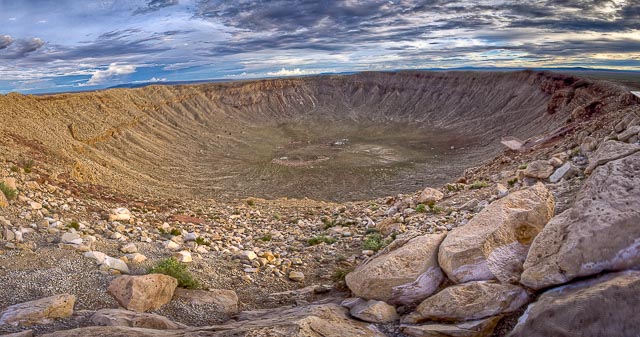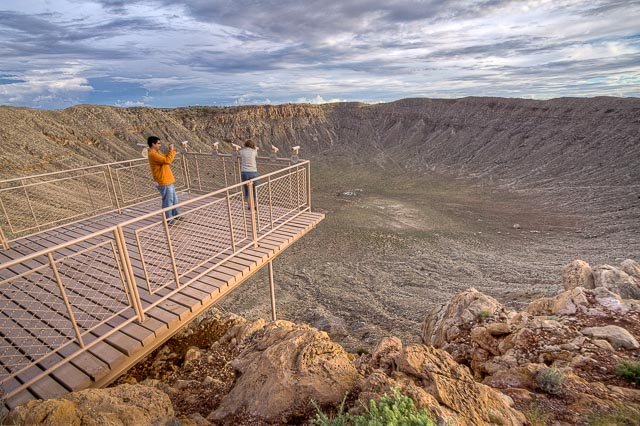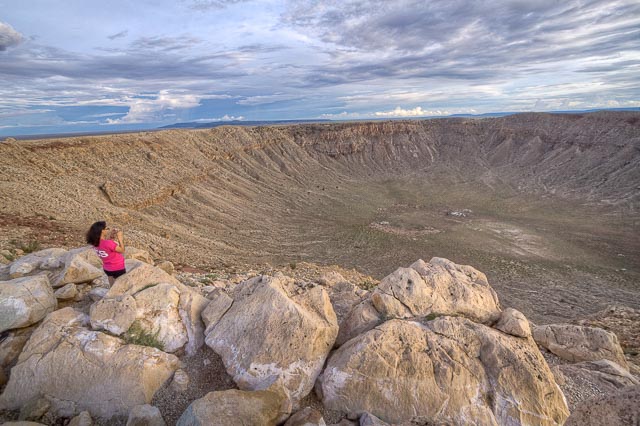Meteor Crater

Fifty thousand year ago, a giant fireball streaked across the North American sky. It struck the Earth in what is now northern Arizona, exploding with the force of 2 1/2 million tons of TNT, or about 150 times the force of the atomic bomb that destroyed Hiroshima. The meteorite weighed 300,000 tons and traveled at a speed of 26,000 miles per hour. Most of the meteorite was melted by the force of the impact, and spread across the landscape in a very fine, nearly atomized mist of molten metal. Millions of tons of limestone and sandstone were blasted out of the crater, covering the ground for a mile in every direction with a blanket of shattered, pulverized and partially melted rock mixed with fragments of meteoritic iron.
When the dust settled, what remained was a crater three-quarters of a mile (about 1 kilometer) wide and 750 feet deep. The impact occurred during the last ice age, a time when the Arizona landscape was cooler and wetter than it is today. The plain around it was covered with a forest, where mammoths, mastodons and giant ground sloths grazed. The force of the impact would have leveled the forest for miles around, hurling the mammoths across the plain and killing or severely injuring any animals unfortunate enough to be nearby. Over time, the landscape recovered. A lake formed in the bottom of the crater, and sediments accumulated until the bowl was only 550 feet deep. Then, with the ending of the ice age, the climate changed and dried. The desert that we see today has helped to preserve the crater, by limiting the erosion that might otherwise have blurred or erased the traces of the ancient impact.
Meteor Crater Observatory

Ruins from the Meteor Crater Observatory located on Route 66. The structure was built by D.M. Barringer for tourists to view the Meteor Crater.
In the mid-1930′s, Harry and Hope Locke built the impressive Meteor Crater Observatory on Route 66 near the Meteor Crater in Arizona, west of Winslow. It was soon closed down due to lack of visitors, and a huge debt incurred during construction. However, in 1946 Dr. Harvey Nininger re-opened the observatory as the American Meteorite Museum -dedicated to the study of meteorites. Dr. Nininger worked and lived in the observatory for many years. Visitors could pay 25 cents to peer through the telescope in the observatory tower at the huge meteor crater 6 miles to the south. Today, only ruins remain.
Where it is:
Barringer Crater or Meteor Crater is a natural landmark near US Route 66 (just 5.8 miles south of I-40’s Exit 233) 18 miles west of Winslow Arizona and 37 miles east of Flagstaff Arizona.
Maps:
Interactive Google Map
Use the map + – controls to zoom in and out, click and drag the to move the map, use the Map drop-down to change to “Map”, “Satellite”, “Hybrid”, or “Terrain” views. Drag the little man icon from the upper left corner to a map location for street level view.
GPS:
35°1’57.3437″ N 111°1’15.574″ W
Cost:
| GENERAL ADMISSION RATES | ON-SITE | WEBSITE |
|---|---|---|
| Adults (age 13 to 59) | $22 | $20 |
| Seniors (age 60 & older) | $20 | $18 |
| Juniors (age 6 to 12) | $13 | $11 |
| Non-Active Duty U.S. Military/Veterans (with I.D.) | $13 | $11 |
| Active Duty U.S. Military | FREE | FREE |
Hours:
OPEN DAILY
8:00 AM – 5:00 PM
Open until 12PM on Thanksgiving Day & Closed Christmas Day
Meteor Crater Photo Gallery
Click Here for full page gallery
More Photographic Destinations in Arizona
Interactive Google Map
Use the map + – controls to zoom in and out, use the Map drop-down to change to “Map”, “Satellite”, “Hybrid”, or “Terrain” views. Drag the little man icon from the upper left corner to a map location for street level view. Click on a pushpin for more information about the Photographic Destination, then click on the title to go to the location page.
Click Here for Photographic Destinations by State




